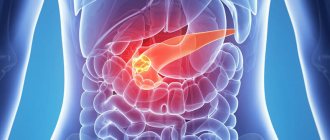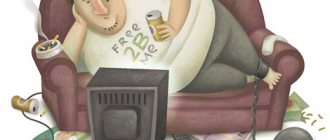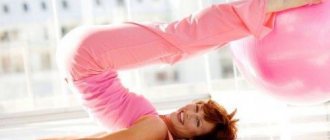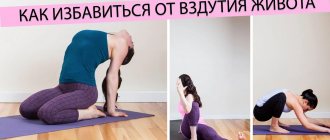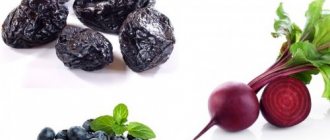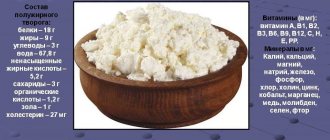Exercises for the intestines for constipation show especially good results if the pathology is caused by a sedentary lifestyle or impaired intestinal motor function. Exercises when defecation is delayed help improve intestinal motility, and also allow you to strengthen the muscles of the diaphragm, abs, pelvic floor, and stimulate the release of gases if the patient has flatulence. To effectively treat defecation retention, gymnastics must be performed regularly.
Features of charging
Before you start exercising, it is important to choose the right set of exercises. Depending on the type of constipation, the type of charging may differ slightly:
| Type of constipation | Features of the pathology | Recommended Exercises |
| Atonic | Defecation does not occur due to weakening of the intestinal muscle tissue. The functionality of the intestines is impaired, the contents do not move out well. This pathology occurs after diseases of the digestive system and abdominal type surgical interventions. As a rule, stool is rare but plentiful. Feces have a dense consistency. With this form of constipation, there is a risk of developing hemorrhoids | With this form of constipation, exercises are carried out at an average pace. Gymnastics should be done regularly 2-3 times a day. Patients with atonic constipation are prescribed the following exercises: · springy movements - improve intestinal motility; · strength training – includes resistance, weight lifting (weight should be discussed with a personal trainer); · gymnastics aimed at strengthening the abdominal muscles - abdominal pumping; light jogging, squats or jumping |
| Spastic | The functionality of the intestines is not impaired, but the patient is bothered by severe spasms that prevent the excretion of intestinal contents. With this form of constipation, the following symptoms are observed: goat feces (peas), increased gas formation. In addition, it seems to the patient that even after defecation, emptying did not occur completely. When straining during defecation, the patient feels a sharp pain in the anus | In case of spastic constipation, the patient is prescribed gymnastics to help relieve spasm. With this kind of training, it is important to maintain a calm pace. Excessive loads are contraindicated. The following exercises are recommended for patients: · relaxing gymnastics; · therapeutic exercises, which are prescribed to patients with osteochondrosis of the lumbar spine; visiting the pool, swimming |
Purgation
To avoid constipation, it is important not only to evacuate feces in a timely manner, but also to prevent their further accumulation. For this purpose, your doctor may prescribe stool-regulating therapy. The problem of constipation should be taken seriously, since prolonged accumulation of feces in the intestines can not only injure its mucous membrane, but also lead to more serious consequences (for example, intoxication of the body, the development of hemorrhoids, anorectal diseases and much more).
Up to contents
The information in this article is for reference only and does not replace professional advice from a doctor. To make a diagnosis and prescribe treatment, consult a qualified specialist.
* V.F. Privorotsky, N.E. Luppova. Modern approaches to the treatment of functional constipation in children // RZHGGK. – 2009. – T.19. – No. 1. – P.59–65.
Features of exercises for constipation
Constipation is a rather unpleasant problem, in which there is a complete disorder of the intestines. The process of treating constipation is based on several methods: diet, special consumption of necessary foods that have a beneficial effect on the process of bowel movements (balanced diet), taking the optimal amount of fluid.
A large amount of gymnastic exercises can effectively help improve bowel function. Thus, the process of excretion of feces and decay products is noticeably accelerated. Science has long established that a sedentary lifestyle is the fundamental basis for the appearance of physical inactivity. But what about a person who has a sedentary job (office worker, truck driver, etc.)? The answer lies in systematic exercise, which significantly increases the tone of the intestinal muscles. This activity should become the norm. What exercises are these? How should it be done correctly? What is effective treatment?
Physical activity is a fairly effective mechanism for relieving the body of constipation. A person can simply get up early in the morning and move around. To do this, you need to perform the simplest exercises that are familiar to us from school physical education lessons. Even basic walking every day for 10-15 minutes helps the digestive system to function effectively in optimal tone. Jogging, dance classes, swimming in the pool. All these aerobic exercises have a positive effect on the patient’s condition and speed up the treatment of the gastrointestinal tract (symptoms of inflammation).
Drug treatment
Taking laxatives is only indicated if acute constipation has developed. The drugs are taken for a short time and under strict medical supervision, as they can lead to symptoms such as “lazy bowels”, where strong stimuli are required to stimulate motility.
For coprostasis, antispasmodic drugs, probiotics and prebiotics, laxatives and carminatives can be prescribed. In the treatment of proctogenic constipation, rectal suppositories and microenemas are indicated. If the patient is diagnosed with intestinal hypermotility, then electrophoresis with antispasmodics is prescribed, magnesium supplements are indicated, and calcium is useful for hypomotility.
Decoctions and infusions are prepared based on plant raw materials.
To stimulate intestinal function, a specialist may prescribe medications:
- irritating intestinal receptors (Guttalax, Picolast, Ganaton, Zirid, Bisacodyl). The products may contain herbal components (senna, buckthorn) or synthetic ones (sodium picosulfate, bisacodyl). 6–10 hours after ingestion, bowel movement occurs;
- normalizing motor skills (“Fractal”). The products stimulate the production of the hormone serotonin, which is responsible for intestinal motility and the release of digestive enzymes. Their effect is noticeable only a few days after the start of treatment;
- relieving spasms (“Mebeverine”, “Spasmomen”). The product eliminates spasm, which leads to an increase in intestinal lumen and elimination of painful sensations;
- having a laxative effect. Medicines differ in their mechanism of action. Some increase the volume of stool by absorbing liquid (Mukofalk, Defenorm), others soften the stool, which makes it easier to remove (glycerin suppositories, petroleum jelly). Preparations based on lactulose (Duphalac, Lactuvit, Normaze) can also be used, since it not only retains water in the intestines, but is also a substrate for beneficial bacteria;
- normalizing the composition of intestinal microflora (“Lactobacterin”, “Bifiform”, “Estralakt”, “Bifidumbacterin”). It is believed that beneficial bacteria suppress the growth of pathogenic microflora, improve colon motility, and normalize the functioning of the gastrointestinal tract. In order to populate the intestines with the necessary bacteria, they prescribe either the intake of live bacteria themselves, or substances that provide food for them.
Special breathing exercises
For constipation, it is very useful to master special diaphragmatic breathing. Such breathing exercises for constipation can be done both during and after physical exercise. It is better to start mastering diaphragmatic breathing while lying on your back:
- Place your hand on your stomach and exhale so that your stomach moves towards your spine.
- Next, exhale, as if taking in air with your stomach, so that your stomach goes up as much as possible. With your hand you can control the movement of the abdominal wall.
- As soon as the hand falls down, take a deep breath, and as soon as it rises, take a deep exhale.
- Having mastered diaphragmatic breathing while lying down, try doing breathing exercises, first sitting and then standing.
When you have thoroughly mastered the technique of breathing exercises for the intestines for constipation, begin to use it not only during physical exercise, but also separately, as an independent complex. Before starting gymnastics, it is better to consult a doctor to determine whether there are any contraindications to performing the exercises.
Vegetarian food
Any plant food contains fiber in excess, which cleanses the intestines. Therefore, vegetarians do not even know what constipation is. Meat and meat products, as well as animal fats contained in milk, cheese, sour cream, butter, contribute to the concentration of waste and the high content of bile acids in them, which not only provokes constipation, but also makes them dangerous for the intestinal mucosa. Pectins have the exact opposite effect, which are delicate fibers that are beneficial for the mucous membrane, cleansing it like a soft sponge. There are a lot of them in baked apples, pumpkins, and zucchini. Try eating for a while with an excess of plant fiber in your diet, and you will forget about intestinal problems. Vinaigrette with vegetable oil, salads made from raw cabbage, carrots and apples, and greens are very useful.
Simple exercises for constipation
An effective, simple exercise is abdominal protrusion. You need to stand up straight, straighten your back, slowly inhale, pull in your stomach, and exhale, push it out. This strengthens the abdominal wall and improves bowel function. Complex cases of constipation require a set of regular exercises:
Supine position:
- With your knees bent at right angles, bring your legs together and spread them 15 times.
- Pull the bent legs towards the stomach with the help of your hands in the same way, return them to the starting position, and straighten them (101005 times).
- Connect your legs, lift them off the floor, lower them after 30 seconds. Do 3 approaches.
- Imitation of cycling (done at a slow pace). Time: 3-5 minutes.
- With one leg bent, reach the floor with a straight leg, while it is important to ensure that the lower back and shoulders do not rise. The exercise is done alternately with each leg (101005 times).
Kneeling position:
- Stretch your arms in front, alternately lift your legs up (the legs cannot be straightened at the knees). Regular exercise will be beneficial for the intestines and back.
- Elbows on the floor, back straight, head down. From this position, alternately squat left and right. Make sure your back doesn't arch.
- Palms on the floor. Alternately moving the legs bent at the knees back.
- Palms rest on the floor, take a deep breath. As you exhale, bend down, relaxing your abdominal muscles as much as possible. While inhaling, take the starting position. Take a deep breath again and arch your back upward (hissing cat pose). Take the starting position (repeat 10 times).
Pronation:
- Inhale - raise your leg up, exhale - lower it. Repeat 15 times for each limb.
- While inhaling slowly, you need to push your stomach out as much as possible, and while exhaling, pull it in. Repeat 10 times.
- The hands are located under the shoulders. Without lifting your limbs from the floor, get on all fours and smoothly roll onto your feet. Take the starting position. It is important that the brushes do not come off the floor. Repeat 5-7 times.
Standing position:
- Running in place (2-3 minutes).
- Alternately raise your legs up. During the exercise, it is important to pull your legs towards your stomach as much as possible. Hands are on the belt. The exercise should be repeated up to 10 times.
- The next exercise consists of walking in place, smoothly turning into rolls from heel to toe and back (2 minutes are allotted for the exercise).
- Take a deep breath and squat as you exhale. It is important that your feet do not leave the floor. If necessary, you can hold your hand on the wall or table. Repeat 5100 times.
- Raise your arms up as you inhale, as you exhale you bend over, while your arms drop down and your stomach retracts. Repeat the exercise 71,000 times.
Prevention measures
Preventive recommendations By following these simple preventive recommendations, you will improve the functioning of your intestines and get rid of constipation:
- drink a glass of warm, clean water every morning;
- eat more fresh vegetables and fruits;
- limit the consumption of fatty, starchy and astringent foods;
- eat regularly, at the same time of day;
- try to get enough sleep;
- be less nervous;
- walk more in the fresh air;
- exercise regularly;
- drink less strong tea and coffee;
- give up dry snacks; you can replace them with prunes and dried apricots;
- eat more cereals; Chew your food thoroughly;
- add fiber to cereals and baked goods;
- eat more dairy products.
With constipation in adults, more serious diseases of the internal organs can occur. Be sure to consult your doctor if you have irregular bowel movements. If the doctor does not find any serious health problems, try to solve the problem without the use of medications.
Correction of diet
Consumption of foods containing dietary fiber. To prevent constipation, you should increase the amount of products with a so-called laxative effect, that is, those containing dietary fiber. These are fresh fruits and vegetables, nuts and beans, bran (in particular, bran bread), and dairy products. It is recommended to reduce consumption or completely exclude from the menu pureed dishes (for example, puree soups, cream soups), viscous, easily digestible porridges (semolina, porridges from crushed cereals), strong black tea, red wine, cocoa products, blueberries, persimmons, pomegranate . These products have a so-called constipating effect and contribute to constipation. Meat and flour products should be consumed with caution.
Drinking the optimal amount of water. To a large extent, the motor activity of the colon depends on the consistency of the intestinal contents, that is, on the amount of water in the stool. In order to avoid constipation, you should drink 1.5–2 liters of fluid per day (in the absence of contraindications), and sugar-free compotes and fruit drinks are preferable to plain boiled water, coffee, black tea and carbonated drinks.
Up to contents
What do experts advise?
If for some reason you can’t do gymnastics in the morning, you can do the exercises during the day, but you just need to make sure that at least 2 hours have passed from the moment of your last meal to the actual gymnastics class. You can not limit yourself to the set of exercises proposed below and additionally perform others that you can do and will not cause overwork or complications of cardiovascular diseases and musculoskeletal problems.
Since one of the most common causes of constipation is physical inactivity, increasing physical activity and mobility will definitely be beneficial. The main thing is that you don’t need to be overzealous and do heavy strength exercises or immediately start with high loads. Everything should be done gradually and to the best of your physical abilities.
